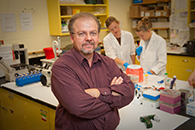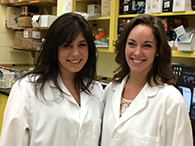Partnership with national laboratory brings latest diagnostic tests to university
Monday, Oct. 20, 2014
MANHATTAN — A Kansas State University veterinary medicine team is working with Lawrence Livermore National Laboratory to bring "Star Trek technology" to the university and improve diagnostic tools for infectious diseases. The research partnership also is providing new opportunities for students.
"Lawrence Livermore National Laboratory is developing some of the top technology tools in the field," said Raymond "Bob" Rowland, professor of diagnostic medicine and pathobiology in the university's College of Veterinary Medicine. "The idea is to take some of this 'Star Trek technology' and bring it to diagnostic laboratories and the clinical practice level."
This advanced technology includes an "everything test" called the Microbial Detection Array. The test is a comprehensive diagnostic test that Lawrence Livermore National Laboratory developed to check a single sample for 8,000 different microbes, such as viruses, bacteria and fungi. Rowland and his research team are applying some of the national laboratory's technology to studying porcine diseases, which are the focus of Rowland's research.
Rowland's research team includes Rebecca Ober, Winnetka, Illinois, and Jamie Thompson, Oak Ridge, New Jersey. Ober and Thompson are both second-year students in veterinary medicine and doctoral students in biomedical science. They spent the summer at Lawrence Livermore National Laboratory improving their research skills and learning more about the laboratory's technology. The students will use the knowledge they gained to translate the Microbial Detection Array to Rowland's laboratory.
The Microbial Detection Array also can test any sample, including blood, dirt, tissue, or a nasal or saliva swab. The test is very valuable for public health, vaccine safety, food safety, biodefense and animal health, Rowland said.
"We want to figure out how to apply this test and make it useful for the veterinarian, the livestock producer or the clinician," Rowland said. "In this project, we are the people grounded in the field and Lawrence Livermore National Laboratory is grounded in technology."
The test is designed to look at three aspects of infectious diseases:
• Endemic, or known, diseases
• Emerging diseases
• Foreign animal diseases, which are diseases that are not present in the U.S.
"Traditional thinking uses three separate tests for all of these diseases," Rowland said. "But the microarray integrates everything and can test for all three types of diseases at once. It's not only an integration into one test; it's an integration of thinking."
Collaborators at Lawrence Livermore National Laboratory include Crystal Jaing, group leader in applied genomics with the laboratory's Biosciences and Biotechnology Division. Ober and Thompson worked with Jaing during their summer at the national laboratory.
"We were able to have hands-on experience in everything they were doing," Thompson said. "We weren't treated as students; we were treated as peers."
The students performed DNA and RNA amplification, purification and labeling. They also worked with a variety of samples, including dolphin, woodchuck, mink and pig samples.
"I think it definitely helped us learn how to interact with other scientists," Ober said. "We were required to learn fast, think fast and deliver."
The research partnership with Lawrence Livermore National Laboratory has received support from the Kansas National Bio and Agro-defense Facility Transition Fund, Rowland said. Ober and Thompson also have received training in the university's Biosecurity Research Institute, and much of the future research will be conducted there, particularly work involving emerging diseases and foreign animal diseases.


